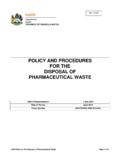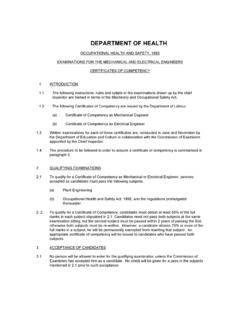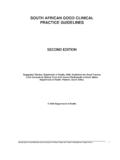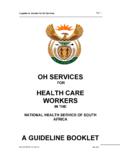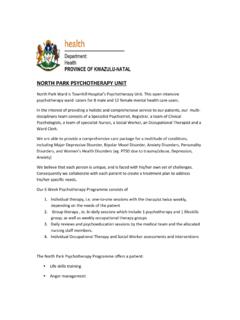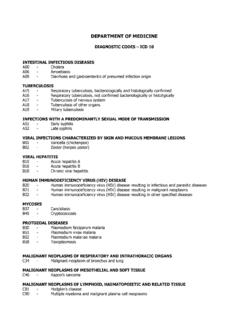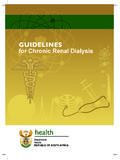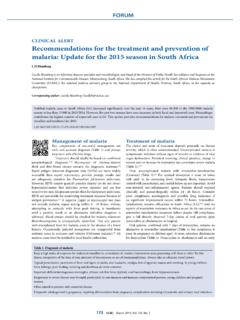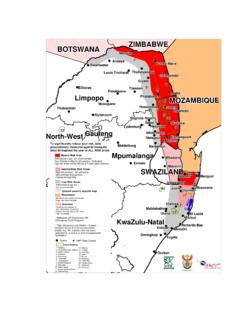Transcription of Leprosy control in South Africa : Leprosy can be cured
1 Leprosy control IN South Africa Leprosy CAN BE cured Leprosy control IN South Africa Compiled by the Department of Health in collaboration with the Leprosy Task Group and The Leprosy Mission (Southern Africa ) June 1998 Obtainable free of charge from: The Department of Health, Pretoria (See back page for the order form) ABSTRACT Leprosy , a communicable disease , caused by Mycobacterium leprae, is a notifiable medical condition. Notificatiopns in 1992 gave an estimated prevalence of 000 of the population, with most of the cases occurring in the Eastern coastal areas and the South -Eastern Highveld. Although the prevalence of Leprosy is low, about 4000 people in South Africa need medical and social care. Hospitalisation is no longer recommended for Leprosy patients as the emphasis now on treatment in the community.
2 New cases of Leprosy are at risk of becoming disabled, especially if not diagnosed early or treated appropriately. This document is issued by the Department of Health. The objective is to provide those involved in the treatment of Leprosy with a clear and practical guide. The outcome aimed for is higher awareness of Leprosy , which would contribute to timeous and appropriate treatment. The development of this document was initiated by the Department of Health and the Leprosy Task Team Group, a committee consisting of experts in the field of Leprosy . The draft document was also subject to review by the Communicable Disease control Officers of the nine provinces and The Leprosy Mission (Southern Africa ). The final concept was compiled by Dr Rajendra Maharaj, Directorate for Communicable Disease control , national Department of Health. The contents deal with the prevalence of Leprosy in South Africa , the detection of Leprosy cases, the procedures to be adopted in cases of suspected Leprosy , diagnosis, classification of Leprosy and the treatment of the disease are also dealt with in this document.
3 Telephone numbers of the Leprosy clinics throughout the country are also provided as well as the contact numbers of the people in charge of these clinics. The contact details of the dermatologists dealing with Leprosy in each province are also provided. Annexures outlining the categorization and treatment of Leprosy are also provided. CONTENTS GOAL AND DISEASE DETECTION OF Leprosy PROCEDURES TO BE ADOPTED IN CASES OF SUSPECTED Leprosy 2 Symptoms of 2 Confirmation by a biopsy ..2 REFERRAL AND TREATMENT PROGRAMME National Provincial At a peripheral NOTIFICATIONS AND THE ROLE OF THE Leprosy MISSION (SOUTHERN Africa )..5 ANNEXURE A: LIST OF DERMATOLOGISTS ASSISTING THE Leprosy ANNEXURE B: HISTOLOGICAL CLASSIFICATION OF ANNEXURE C: LIST OF Leprosy ANNEXURE D: PERSONS AT THE Leprosy MISSION (SOUTHERN Africa ) RESPONSIBLE FOR THE Leprosy ANNEXURE E: TREATMENT OF ANNEXURE F: MINIMAL ACCEPTABLE TRAINING STANDARDS IN Leprosy FOR GENERAL HEALTH INTRODUCTION Leprosy , a communicable disease, caused by Mycobacterium leprae, was declared a notifiable disease in South Africa in 1921.
4 Notifications in 1992 gave an estimated prevalence of 000 of the population, with a concentration of cases in the Eastern coastal areas and the South -Eastern Highveld. Prevalence in South Africa is below 1 per 10 000 of the population, the World Health Organization (WHO) cut off point for considering Leprosy as a Public Health problem. Hospitalisation for treatment was compulsory until 1977. The emphasis today is on treatment in the community. The Leprosy Mission (Southern Africa ) states that about 4 000 people in South Africa , though no longer suffering from active disease, need medical and social care. New cases of Leprosy are at risk of becoming disabled, especially if not diagnosed early or treated appropriately. A national policy is required to ensure the utilization of current expertise and resources in developing a targeted approach to Leprosy control in South Africa .
5 The national policy aims to prevent transmission, treat patients at early stage of the disease and care for and rehabilitate those people, who are cured , no longer infectious, but are still disabled by Leprosy . This disability is at risk of increasing because of the loss of awareness of pain. GOAL AND OBJECTIVES GOAL The goal of the Leprosy programme is to decrease the current prevalence of Leprosy in order to move towards the eradication of Leprosy . OBJECTIVES The objectives of the programme are to: 1. Develop standard guidelines for the early diagnosis and management of cases and update these regularly. 2. Prevent disability and rehabilitate all disabled patients. 3. Establish a central register and measure the treatment outcomes. 4. Ensure that there is at least one medical doctor with Leprosy expertise in each teaching hospital to which Leprosy cases can be referred, and whose records are linked to the central register.
6 5. Ensure that the early diagnosis of Leprosy is included in the PHC training material of health professionals. DISEASE MANAGEMENT DETECTION OF Leprosy CASES A case of Leprosy is defined as a person in need of/ or on chemotherapy for Leprosy . When prevalence is low, as in South Africa , the following are recommended: Assist health workers to recognize the early signs and symptoms; Examine all household and other close contacts of new cases Increase neighbourhood awareness, which leads to self reporting. PROCEDURES TO BE ADOPTED IN CASES OF SUSPECTED Leprosy History of known contact with Leprosy is most important and should result in a high index of suspicion. Initial screening by a local dermatology department is preferred where available (see Annexure A). Suspected cases seen at health centre level should be referred to the nearest provincial Leprosy centre were the patient should be managed in full.
7 DIAGNOSIS Diagnosis should be: Based on clinical signs and symptoms of Leprosy ; and Confirmed by a punch biopsy or skin smear (where the expertise exists) Symptoms of Leprosy Early signs and symptoms of Leprosy include: Diminished sensitivity to cotton wool touch, in a patch on the skin; and Enlargement of peripheral nerves in specific sites. Both signs should be present to make a diagnosis and treatment should be started at once. Confirmation by a biopsy A punch biopsy should be carried out to confirm the diagnosis if at all possible. The punch biopsy tool is readily available at a minimal cost. The biopsy should be a punch biopsy on the edge of the lesion so that it includes affected and normal skin, including the deep dermis. CLASSIFICATION Before starting treatment, it is essential to classify a Leprosy patient s condition.
8 This should be done according to the Ridley and Jopling classification for distinguishing between tuberculoid and lepromatous Leprosy (see Annexure B). For the purposes of multidrug therapy, patients are also classified as Paucibaccilary(smear negative, or Multibacillary (smear positive). REFERRAL AND TREATMENT CENTRES The provincial Departments should identify a diagnostic referral centre(s). A list of approved referral centers (diagnostic centers), should be available and accessible to health workers at all times (Annexures C and D). To prevent delay in confirmation of diagnosis and treatment, the details required by the referral centre should be clearly stated. TREATMENT Treatment programmes should form part of a community health service and the WHO recommended Multidrug Treatment (MDT) regimen should be prescribed (Annexure E). Anti Leprosy treatment should continue for 6 months(PBL) and 12 months (MBL).)
9 Only if the lesions do not look healed should the patient be referred for the lesions do not look healed be patient be referred for expert opinion. REHABILITATION Programmes for the disabled should community based, following a holistic approach. These people are in need of physical, psychological, spiritual, social and economic rehabilitation. The Leprosy Mission can help to mobilize support for the patient in the community. PROGRAMME MANAGEMENT IMPLEMENTATION National level The following essential activities will be the responsibility of the national Department of Health in collaboration with The Leprosy Mission (Southern Africa ): To keep and maintain one national Leprosy register, linked to provincial registers. To produce an annual report based on the central register. To arrange for a Leprosy expert to act as consultant to the Department of Health and other interested parties.
10 Provincial level This level will be responsible for the following: Confirmation of diagnosis- a punch biopsy should be taken and sent to the national Leprosy consultant; Initiation of treatment; Return of patients to the referring institution for continuation of treatment; Notification of cases; Providing advice to health workers on the recognition and management of complications; Admission of patients to the general wards for the treatment of reactions and complications if necessary. At a peripheral level Health workers should be able to recognise (early) signs and symptoms of Leprosy (Annexure F). Suspect cases need referral to a referral centre (where available): the dermatology department of an academic centre or a dermatologist in one of the hospitals. Clinics remain responsible for total personal care.
